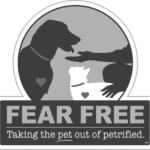Brusha, Brusha, Brusha: Five Essentials of Dental Care
February 4, 2014
February is National Pet Dental Health Month. Yay for oral hygiene! As I previously discussed, dental disease is the most prevalent illness in our domestic dogs and cats, but the good news is that it can be prevented more readily than many diseases we see. There are so many misconceptions about pet dental health, treatment and prevention. What are the top five things you need to know about Fluffy and Fido’s teeth?
1.) Dry pet food does not prevent dental disease! Have you ever seen Fido wolf down his bowl of kibble? He probably doesn’t chew more than a nugget or two, instead inhaling them whole. Even if he were to crunch individually on each piece of dog food, kibble does not act like a toothbrush and effectively “scrape” clean the teeth. The majority of pets we see are feed dry food, and yet the majority of pets we see have dental disease. Feeding kibble, unless it is a prescription dental diet, does not replace the need for tooth brushing.
2.) Bad breath is not normal in cats and dogs, and it is almost always a sign of dental disease. It’s simple enough. Supplements and water additives that claim to freshen breath may mask the odor, but do not address the underlying cause.
3.) Even though you may see a huge number of “oral care” products in the pet store for Fluffy, the majority of them have absolutely no evidence to prove they work and most are a waste of money. The Veterinary Oral Health Council has independently tested a variety of dental foods, treats, supplements and tools, and given their seal of approval to a select few. If you see the VOHC seal on a product, then that product is likely to yield a benefit to Fluffy’s teeth. Nothing, however, will replace or avoid regular, comprehensive dental cleanings under general anesthesia, such as discussed in my previous blog post.
4.) Whether or not Fido yelps when you touch his mouth, or whether or not Fluffy has stopped eating her dry food in favor of wet, we know that dental disease is painful. Gingivitis hurts. Loose teeth hurt. Feline odontoclastic resorptive lesions really hurt. Our pets are hard wired to hide signs of pain from us, so they do. Imagine not having one toothache, but ten. And that’s probably what Fido feels every day of his life- but he’s not going to cry, stop eating or act lethargic unless the disease is significantly advanced.
5.) The single best thing you can do to keep Fluffy’s mouth healthy is to brush her teeth once a day, every day! It’s easiest to start daily dental care with new puppies and kittens, to acclimate them to the process. Even older pets can be taught to sit for tooth brushing, if you are persistent and patient (and if Fluffy gets a reward at the end for her efforts.) There are a variety of pet toothbrushes and toothpastes available for purchase at Newtown Square Veterinary Hospital; please ask us what might work best for your pet. Some trial and error may be needed to find what works best, but persistence is key!



